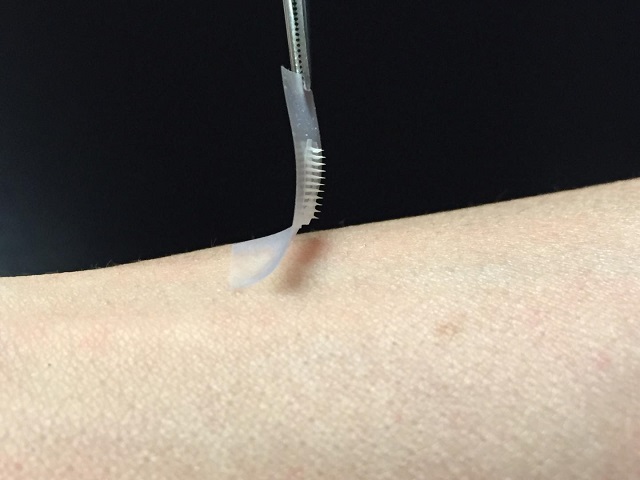A new smart insulin patch developed by a team of researchers at the University of North Carolina and NC State can detect blood sugar level increases and administer a dose of insulin into the bloodstream as needed, eliminating the need for painful insulin injections for diabetics.

The ‘smart insulin patch’ is a thin square a couple of millimetres large. Its surface is made up of over 100 miniscule needles which store insulin and enzymes that sense glucose in microscopic storage units. These ‘microneedles’ painlessly penetrate the skin and make contact with the blood flowing in capillaries just below the surface.
The research team found that the new patch could reduce blood glucose levels in a mouse model of type 1 diabetes for as long as nine hours. This suggests great promise for human use, with further pre-clinical tests and human clinical trials to come.
The future potential of the device is highlighted by co-senior author Zhen Gu, PhD, a professor in the Joint UNC/NC State Department of Biomedical Engineering: "The whole system can be personalized to account for a diabetic's weight and sensitivity to insulin, so we could make the smart patch even smarter." He adds that the patch “works fast, is easy to use, and is made from nontoxic, biocompatible materials."
Affecting more than 387 million people worldwide, diabetes is currently maintained with frequent finger prick tests and insulin shots to control blood glucose levels. This process is painful and can be imprecise. John Buse, MD, PhD, co-senior author of the PNAS paper, explains how important an accurate medication method is: "Injecting the wrong amount of medication can lead to significant complications like blindness and limb amputations, or even more disastrous consequences such as diabetic comas and death."
This research team have removed the risk of human error by emulating the natural insulin generators of the body – beta cells. These cells both create and store the insulin in small sacs called vesticles. If they sense an increase in blood glucose levels, they can signal the release of insulin into the blood stream.
We constructed artificial vesicles to perform these same functions by using two materials that could easily be found in nature.
Jiching Yu, PNAS first author and a PhD student in Gu’s lab
Hyaluronic acid and 2-nitromidazole were connected to create a new double ended molecule, with one side hydrophilic and the other hydrophobic. When these molecules self-assemble into a vesicle, their hydrophilic ends pointed outward and the hydrophobic ends pointed inward, producing a vast number of bubble-like structures that were each one hundredth of the diameter of a human hair. A core of solid insulin and glucose-sensing enzymes were inserted into these vesicles.
These spheres of glucose-sensing, insulin-releasing material were then formed into an array of microneedles using a rigid form of hyaluronic acid. These needles were arranged on a thin silicon strip.
The team tested the patch on a mouse model of type 1 diabetes and compared it to injecting insulin as standard. When injected, the bloog sugar levels decreased but soon returned to the hyperglycemic range. The microneedle patch controlled the blood sugar levels within half an hour and remained under control for several hours.
The patch was found to be able to alter blood glucose levels within only a particular range when the dose of the enzyme in the microneedles was changed. Regular insulin injections can cause blood glucose levels to plummet dangerously low – the patch has been found not to pose this risk.
The hard part of diabetes care is not the insulin shots, or the blood sugar checks, or the diet but the fact that you have to do them all several times a day every day for the rest of your life. If we can get these patches to work in people, it will be a game changer.
Buse, director of the North Carolina Translational and Clincal Sciences Institue.
It is thought that the blood glucose-controlling effects of the patch may last longer for humans as they are more sensitive to insulin. It is hoped that a patch will be developed that only needs to be changed every few days.